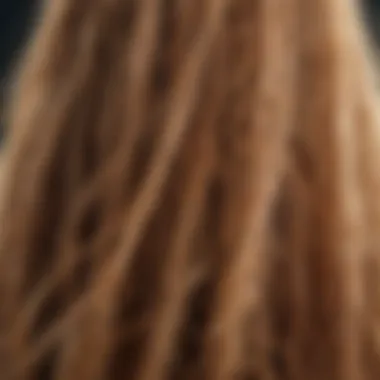Effective Conditioning Techniques for Dry Hair


Intro
Dry hair is a common concern for many women, impacting how hair feels and looks. Underlying factors such as environmental conditions, heat styling, and chemical processes can lead to compromised hair health. Conditioning is a vital part of any hair care routine, especially for dry hair. The right conditioner can restore moisture, improve manageability, and enhance shine. In this article, we will explore the reasons behind dry hair, the benefits of using conditioner, and various effective techniques to achieve better results.
Trending Topics
Current Fashion Trends
As hair continues to be an integral part of personal style, trends emerge that focus on health and vitality. Women are prioritizing hair care as much as fashion statements. This shift leads to a greater emphasis on nourishing hair, making the use of effective conditioners essential. Styles trending today often feature natural, flowing textures, which can be achieved only if the hair is well-maintained and hydrated.
Beauty Innovations
The hair care industry continuously evolves, with numerous innovations aimed at improving hair health. Products with advanced formulas that target dry hair specifically are now more accessible. Ingredients like argan oil, jojoba oil, and shea butter are among those increasingly used in conditioners. These components not only moisturize but also offer protection against damage.
Understanding Dry Hair
Recognizing the reasons behind dry hair can help tailor the conditioning approach used. Factors may include:
- Lack of moisture: Environmental dryness, frequent washing, or insufficient hydration can lead to dryness.
- Heat damage: Curling irons and blow dryers can strip essential moisture from the hair.
- Chemical treatments: Dyeing and perming can compromise the hair's natural structure.
Understanding these factors allows for a more informed choice in the types of conditioners and techniques to employ.
Benefits of Conditioning
Applying the right conditioner provides several advantages, including:
- Restoration of moisture: Conditioners help replenish lost moisture, leaving hair softer and more manageable.
- Improved shine: A good conditioner can enhance the natural luster of hair, making it appear healthier.
- Detangling properties: Conditioners reduce knots and tangles, making combing or styling easier.
Conditioning can transform dry, dull hair into a soft, vibrant mane. Proper use may yield impressive improvements in texture and overall health.
Choosing the Right Conditioner
Selecting a suitable conditioner depends on hair type and specific needs. Both leave-in and rinse-out options exist. Leave-in conditioners work to maintain moisture throughout the day, while rinse-out conditioners provide immediate hydration and softness. Considerations include texture:
- Thick hair: Look for heavier formulas that provide deep conditioning.
- Fine hair: Opt for lightweight options that prevent weighing hair down.
Step-by-Step Conditioning Techniques
Using conditioner effectively requires a straightforward approach:
- Wash hair with a gentle shampoo: Start by cleaning scalps to remove buildup.
- Apply conditioner: Use a generous amount, focusing on the ends where dryness is most noticeable.
- Leave for the recommended time: Allow conditioner to sit as per product instructions.
- Rinse thoroughly: Ensure no residue is left, as build-up can lead to greasy hair.
- Style as usual: Follow up with styling products, ensuring not to add heat without a protective serum.
In summary, the effective use of conditioner on dry hair is a powerful tool in achieving healthier hair. Understanding the causes of dryness and the benefits of proper conditioning can significantly contribute to enhancing hair care routines.
Understanding Dry Hair
Understanding dry hair is essential for applying conditioner effectively and achieving healthier hair. Dry hair can present a variety of challenges, making it crucial to recognize its characteristics and causes. This section offers insights that are vital for anyone looking to nourish their hair adequately. Knowing how to identify dry hair and what leads to this condition can lead to better hair care.
Defining Dry Hair
Dry hair is a common issue characterized by a lack of moisture and oils. It often appears dull, frizzy, and may feel brittle to the touch. Individuals may notice increased tangling and split ends as a direct result of dryness. Regular scalp oil production is important for maintaining shiny and healthy hair. When this balance is disrupted, it results in dry strands that do not reflect light well. In summary, dry hair is marked by its inability to retain moisture, leading to various aesthetic and structural problems.
Common Causes of Dry Hair
Dry hair can result from multiple factors, both external and internal. Understanding these causes is vital when looking to employ conditioners and other hair care products effectively. Here are some prominent reasons:
Environmental Factors
Environmental factors play a significant role in drying out hair. Elements such as sun exposure, wind, and dry air remove moisture from the hair. For example, cold winter months can lead to lower humidity levels, contributing to hair dehydration. It is crucial for individuals to consider protecting their hair during harsh weather conditions.
- Key characteristic: Environmentally-induced dryness often leads to brittle hair.
- Benefits: Awareness helps in choosing protective hairstyles or products.
- Disadvantages: Damage may be cumulative and might require more intensive treatment to restore hydration.


Chemical Treatments
Chemical treatments, like hair coloring, perming, and straightening, can significantly affect hair's moisture levels. These processes often strip natural oils, making hair feel coarse and dry. Regular use of such treatments can lead to cumulative damage, further aggravating dryness.
- Key characteristic: Chemical treatments can offer aesthetic benefits, but often at a cost to hair health.
- Benefits: Understanding the effects of these treatments allows for more informed decisions about hair styling.
- Disadvantages: This type of damage often necessitates the use of heavy conditioners to restore moisture and requires careful monitoring.
Incorrect Washing Techniques
Incorrect washing techniques are another factor that can lead to dry hair. Over-washing or using harsh shampoos strips hair of its natural oils. Moreover, not conditioning properly can leave hair open to damage. It is essential to have a tailored hair washing routine to maintain optimal moisture levels.
- Key characteristic: Over-washing can lead to a cycle of dryness and damage.
- Benefits: Being aware of proper washing techniques can simplify the hair care process.
- Disadvantages: Incorrect practices may require significant changes in personal habits for restoration to occur.
Understanding the complex layers that contribute to dry hair creates a strong foundation for applying conditioners effectively. By recognizing the defining qualities and causes of dry hair, one can move forward with a tailored approach to hydration and care.
The Role of Conditioner
Conditioner plays a crucial role in the hair care routine, mainly for those dealing with dry hair. It serves as an essential tool to restore and maintain the desired moisture levels, making hair more manageable and healthy-looking. Understanding how conditioner works can enhance its benefits, especially for individuals with specific hair concerns. This section delves into what conditioner's role is and how it can positively impact dry hair.
What is Conditioner?
Conditioner is a hair care product designed to improve the texture and appearance of hair. It typically contains various moisturizing agents, proteins, and emollients that work together to enhance hair health. When applied after shampooing, conditioner helps to replenish moisture lost during cleansing. Conditioners can be cream or liquid formulations and come in various types, addressing different hair needs.
How Conditioner Benefits Dry Hair
Moisture Retention
Moisture retention is a key aspect of conditioner that directly addresses dry hair. By forming a protective layer around each hair strand, conditioners help to lock in moisture, which is essential for maintaining hair suppleness. This characteristic is particularly beneficial for dry hair types that suffer from dehydration. The unique feature of moisture retention allows hair to appear shinier and feel softer, making it a popular choice for those seeking to improve their dry hair condition. However, overuse can lead to buildup, which may not be desirable in some cases.
Smoothing Cuticles
Smoothing cuticles contributes significantly to the overall improvement of dry hair. Conditioners work to repair the cuticle layer, the outermost part of the hair shaft. This process reduces the appearance of damage and brittleness, promoting a healthier look. Smoothing the cuticles can enhance shine and make hair easier to style. This property makes it a favorable choice for those who regularly heat-style or color their hair. Nonetheless, some formulations may weigh hair down if not chosen carefully.
Reducing Frizz
Reducing frizz is another compelling benefit of using conditioner on dry hair. Frizz often arises from moisture imbalance or damage to the hair cuticle. Conditioners help to tame this unwanted texture by sealing the hair cuticles and preventing moisture from escaping. This aspect is essential for anyone looking to maintain a sleek appearance, especially in humid conditions. The unique feature of reducing frizz is particularly advantageous for those in climates with high humidity levels. However, not all conditioners are created equal, and finding the right one can be crucial to successful frizz management.
Conditioners are vital for restoring moisture, smoothing cuticles, and reducing frizz, making them essential in the hair care regimen for those with dry hair.
Choosing the Right Conditioner
Selecting the appropriate conditioner is crucial for those dealing with dry hair. The right product can significantly elevate the condition of your hair, promoting moisture retention and enhancing overall hair health. It is essential to consider factors such as hair type, the severity of dryness, and specific hair needs. By understanding the various types of conditioners available, as well as their distinct ingredients, you can make a well-informed decision that aligns with your personal hair care goals.
Types of Conditioners
Leave-In Conditioners
Leave-in conditioners serve as a lightweight barrier against environmental stressors. They are designed to be applied to damp hair and left in without rinsing. This characteristic makes them convenient for daily use. They often contain moisturizing agents that penetrate the hair shaft, providing ongoing hydration throughout the day.
The main advantage of leave-in conditioners is their ability to detangle and soften hair. However, they can weigh down fine hair if too much is applied. It's important to use them sparingly to achieve optimal results without the risk of greasiness.
Deep Conditioners
Deep conditioners specialize in intensive treatment for very dry or damaged hair. These products contain higher concentrations of nourishing ingredients, often requiring a longer application time. Typically, deep conditioners work best when used weekly. The high moisture levels can restore elasticity and shine, making hair feel rejuvenated.
While highly effective, deep conditioners may not be ideal for everyday use. Overuse can lead to buildup, affecting hair's natural texture. Moreover, the treatment may take longer than average conditioners, requiring time in your hair care routine.
Regular Conditioners
Regular conditioners are often used after shampooing to maintain a level of hydration. They are typically thicker and more emollient than shampoos. These conditioners aim to smooth the hair cuticle and enhance manageability. They can provide essential hydration when used consistently.
The downside is that regular conditioners are sometimes insufficient for severely dry hair. They may not penetrate deeply enough, leading to temporary results rather than long-lasting hydration. Thus, pairing regular conditioners with specialized treatments may be beneficial for those with dry strands.
Ingredients to Look For


Natural Oils
Natural oils, such as argan oil or coconut oil, offer significant advantages for dry hair. They provide deep hydration and help seal in moisture. They are often beneficial for those wanting to nourish their hair without using heavy chemicals. When included in conditioners, they can enhance shine and softness. The challenge is that some oils can be too heavy, leading to a greasy appearance if not used correctly.
Silicones
Silicones are commonly found in hair conditioners due to their smoothing properties. They coat the hair, providing a protective layer that helps reduce frizz and enhance shine. Their ability to detangle hair is particularly useful for dry strands. However, silicones can cause buildup over time, requiring clarifying shampoos to remove them. Thus, it is wise to consider alternating between silicone-based and natural products for balance.
Proteins
Proteins, including keratin, are essential for strengthening hair. They help to repair damage and can make hair appear fuller. Conditioners containing proteins can provide structural support for fragile strands. On the downside, excessive protein can lead to stiffness, making hair look dull. Balancing protein treatments with adequate moisture is vital for maintaining healthy hair.
Understanding Labels
Understanding ingredient labels is key to making informed choices about conditioners. Many products often highlight flashy claims without offering real benefits. By closely examining these labels, you can identify ingredients that will genuinely benefit your dry hair. Look for terms such as "moisturizing" or "hydrating," along with the active components.
Applying Conditioner on Dry Hair
Conditioner plays a critical role in hair care, especially for those with dry hair. When hair becomes dry, it loses its natural moisture and may appear frizzy or brittle. Applying conditioner correctly can restore hydration and improve overall health. It helps in smoothing the cuticle layer, which in turn makes hair more manageable. Essentially, proper application can mean the difference between damaged, lifeless hair and soft, healthy strands.
Prepping Hair for Conditioning
Detangling
Detangling is an essential first step before applying any conditioner. When hair is dry, it can become knotted and tangled. Removing these tangles before conditioning is crucial for effective treatment. Not only does detangling prevent breakage, but it also allows the conditioner to penetrate the hair more deeply. A wide-tooth comb or fingers can be effective tools for this task, as they gently separate strands without causing harm. Keeping the process gentle is a key characteristic of effective detangling.
The main advatage of detangling first is that it prepares the hair properly, ensuring that the conditioner can work efficiently. On the contrary, if not done, the conditioner may not distribute evenly, leaving some areas untreated.
Choosing the Right Environment
The environment in which you apply conditioner can significantly impact the results. High humidity levels can enhance moisture retention, while dry or windy environments can lead to further dehydration. Choosing a calm, warm space can optimize the conditioning process, as warmth helps open the hair cuticles.
This choice is important because a stable environment facilitates even product distribution and absorption. Additionally, it minimizes external elements that may strip moisture from the hair during the conditioning process. However, one disadvantage might be that finding the ideal conditions may require planning.
Step-by-Step Application Techniques
Sectioning the Hair
Sectioning the hair is a practical approach to ensure that the conditioner is distributed uniformly throughout your strands. By dividing hair into manageable parts, it becomes easy to ensure every section receives attention. This technique is especially important for those with thick or long hair, which can easily hide areas that need treatment.
A notable benefit of sectioning is that it prevents over-application on any single area while ensuring that every part of the hair gets conditioned. However, improperly sectioning can lead to uneven application, potentially leaving some strands under-treated.
Applying Evenly
Applying conditioner evenly is paramount in achieving the desired results. The technique requires gentle application from roots to ends, ensuring that every strand is coated. An even application ensures that no area is neglected, allowing each strand to absorb sufficient moisture.
This method is effective because it maximizes the conditioning benefits, enhancing overall hair texture and shine. Disadvantages exist if uneven application occurs, resulting in some sections feeling greasy and others dry, counteracting the treatment's purpose.
Focusing on Ends
Focusing on the ends of the hair is crucial, as this is where damage and dryness often manifest. The ends may be the most deprived of moisture, making them vulnerable to breakage. By targeting this area, you ensure that it receives the most treatment.
This practice is particularly beneficial because it addresses the most critical parts of dry hair. The unique advantage here is that a little extra product can make a significant difference in the overall appearance. If one neglects the ends, the conditioning effect may be diminished, leading to persistent dryness.
Frequency of Conditioning
Understanding the frequency at which to apply conditioner is crucial for anyone dealing with dry hair. This aspect of hair care determines not only the hydration level your hair receives but also impacts its overall health and appearance. Conditioner plays a vital role in restoring moisture, smoothing out the cuticles, and reducing frizz. However, applying it too often or not enough can lead to unforeseen issues.
Determining How Often to Condition
Daily vs. Weekly Conditioning


The choice between daily and weekly conditioning revolves around the individual needs of your hair. Daily conditioning is typically recommended for those with significantly dry or damaged hair. Doing this can help maintain moisture levels and provide ongoing nourishment. The main characteristic of this approach is its immediacy, delivering nutrients right when the hair needs them most.
On the other hand, weekly conditioning is suitable for those whose hair is in better condition. It allows for a balanced approach, giving hair time to absorb the benefits without overdoing it. One advantage here is that it can save time in your daily routine while still promoting healthy hair.
Ultimately, finding the right balance is essential. Monitor how your hair responds to each method, as preferences can vary widely.
Factors to Consider
When deciding how often to condition, several factors come into play. Firstly, consider your hair type. Curly, thick, or coarse hair often requires more moisture compared to straight or fine hair. The environment also influences this choice; dry or humid climates can affect how often your hair needs conditioning.
Another crucial aspect to think about is your overall hair health. If you regularly expose your hair to heat or chemical treatments, you might need to increase the frequency of conditioning. Listening to your hair is key. Signs of dryness or lack of shine typically signal a need for more frequent applications.
Signs That You Need to Condition More
Recognizing when your hair is in need of additional conditioning is vital. Look out for visible signs such as increased frizz, lack of elasticity, or breakage. These indicators can guide you to adjust your conditioning frequency accordingly. Regularly assessing your hair will help you maintain its health and appearance.
Additional Tips for Managing Dry Hair
Dry hair is a common issue that can be exacerbated by multiple factors, including lifestyle choices and the products used. Understanding how to manage dry hair effectively can significantly enhance its health and appearance. This section presents practical advice aimed at women of all ages, empowering them to make informed decisions about their hair care routines. Incorporating these tips can lead to improved moisture retention and smoother, more manageable hair.
Styling Products to Avoid
When it comes to managing dry hair, being selective about styling products is crucial. Many products on the market contain harsh chemicals that strip moisture from hair and cause further damage.
- Sulfates: These are detergents found in shampoos and sometimes conditioners, known for their lathering properties. While they effectively remove dirt, they also strip the hair of its natural oils.
- Alcohol-based products: Ingredients like isopropyl alcohol can dry out hair and lead to brittleness. Avoiding these products can help retain moisture.
- Heavy waxes and pomades: These can build up on hair, making it appear dull and lifeless. Instead, opt for lighter products that are hydrating and moisturizing.
To avoid these detrimental effects, it is wise to read labels carefully. Choosing products that are labeled as "moisturizing" or "sulphate-free" can be advantageous for maintaining healthy hair.
Best Practices for Dry Hair Care
Caring for dry hair involves more than just the right products; it also requires a thoughtful approach to maintenance and styling.
Regular Trims
Regular trims are essential for preventing split ends and eliminating damaged hair. This practice does not just improve appearance but also allows hair to grow healthier. Trimming every 6 to 8 weeks is considered a beneficial choice. By removing unwanted ends, hair looks fuller and more vibrant.
Trimming is effective because it prevents breaks and tangling. It is often overlooked, yet its simplicity is a critical component in an effective hair care routine. The unique feature of regular trims is that they contribute to overall hair health without requiring extensive time or expense.
Limiting Heat Exposure
Limiting heat exposure is one of the most effective strategies for managing dry hair. Frequent use of heat styling tools such as blow dryers, flat irons, and curling wands can exacerbate dryness and damage hair cuticles.
The key characteristic of this tip is its preventive nature. Reducing the frequency of heat styling allows hair to retain moisture and recover from damage. For those who still wish to use heat tools, employing a heat protectant spray is advisable to minimize adverse effects.
Another unique aspect of limiting heat exposure is the potential to embrace natural hair texture. This can lead to a healthier hair journey, where natural styling methods are favored over heat-dependent ones, reducing overall hair stress.
Integrating these best practices can transform the management of dry hair, offering significant benefits when applied consistently.
The End
Understanding how to utilize conditioner effectively on dry hair is crucial for anyone seeking to maintain healthy, vibrant locks. This article emphasizes several important aspects. First, the role of conditioner is pivotal in restoring moisture and smoothing the hair cuticle, which directly addresses the problem of dryness. A well-chosen conditioner, whether it be leave-in, deep, or a regular option, can make a significant difference.
Moreover, the specific techniques for applying conditioner provide a practical roadmap for users. It is not just about applying the product; it is about knowing how to prepare your hair, what methods to use while applying, and understanding how frequently to use these products. Through this knowledge, individuals can develop a more informed hair care routine that caters to their unique needs.
Additionally, recognizing the signs that indicate your hair may need more attention highlights the importance of being attuned to one's hair condition. Adopting best practices in care, such as avoiding harsh styling products and limiting heat, compounds the benefits of conditioning.
Ultimately, the journey to healthier hair is not instantaneous but rather a continuous process that demands attention and adaptation. By embracing a thoughtful approach to conditioning, readers can foster lasting improvements in their hair's appearance and health.
Summary of Key Points
- Conditioners play a crucial role in combating dry hair by increasing moisture retention, smoothing cuticles, and reducing frizz.
- Choosing the right conditioner involves understanding different types and their ingredients to suit individual hair needs.
- The application technique is essential; preparing the hair properly and knowing how to apply the product can enhance efficacy.
- Recognizing when to condition more frequently based on hair's response is vital for optimal care.
- Avoiding damaging products and practices significantly supports hair health.
Encouragement for Ongoing Hair Care
It is essential to remember that hair care requires consistency and the right knowledge. Continuously educating yourself on the best practices, products, and techniques for conditioning dry hair can lead to substantial improvements.
Engaging with community resources, such as forums on Reddit discussing hair care, can offer shared experiences and diverse techniques. Stay committed to applying what you learn, and don't hesitate to adapt as you discover what works best for your hair.
As you continue your hair care journey, prioritize quality over quantity. Regular conditioning complemented by an understanding of your hair's needs will foster the desired health and appearance. Your efforts in caring for your hair will create rewarding results over time.



